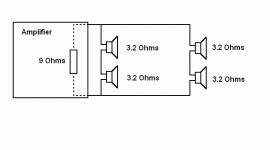Thankfully, I think that that question has been put to rest for the majority of cases.
However, I am about to build some H-frame subwoofers with 4 12" drivers/side which will probably be arranged series/parallel (see picture) to present a reasonable load (that of one driver) to the 40W amp. That is not the end of the story though.
The drivers' specs are
Qts ~ 0.23
Qes ~ 0.26
Qms ~ 2.34
Re ~ 3.2 Ohms.
Fs ~ 28Hz
The plan is to increase Qts to somewhere around 0.7 by increasing Qes.
Qes is dependent on total resistance seen by the driver and can be increased to Qes' by the addition of series resistance (Rx):
Qes'=Qes(Rx+Re)/Re
For one driver, if Rx is 9.3Ohms, Qes' = 1.01
Therefore, 1/Qts'=(1/Qms)+(1/Qes')
gives Qts'=0.707
This series resistance will be achieved by altering the feedback network of a Cambridge Audio A1 Mk3 amp I picked up on ebay for <£15 recently. It only involves soldering about 3 resistors onto the pcb and unsoldering 2. The amp is based on the TDA1514 chip and seems to be very happy with a 4 Ohm load.
Now it gets interesting. If I alter the output impedance of the amp to 9 Ohms (assume 0.3 Ohms speaker cable) and arrange the drivers as shown in the photo, I think that each driver will actually see half of this just as amplifiers see half the real load when operated bridged.
Time for a disclaimer: I could be completely wrong.
Having said that, my reasoning is identical: The total back emf from any series pair of drivers will be double that of a single driver. The current through the pair will therefore be double. Put simply, the emf across any one driver will be as normal but the current will be double ergo --> resistance seen by driver is halved. This means that contrary to the popular misconception that series configuration increases Qes, it actually reduces it by halving the additional resistance, Rx. The effect will be negligible when used with a traditional amplifier where Rx is speaker cable plus about 0.01Ohms.
So what do you guys think?
Am I barking up the wrong tree or do I need 18 Ohms output impedance from the amp to get a Qts of 0.7 and a decent frequency response?
I realise that this may seem like a fairly niche request but the drivers were £12 each from IPL Acoustics so maybe some other people might be tempted to try dipole bass.
However, I am about to build some H-frame subwoofers with 4 12" drivers/side which will probably be arranged series/parallel (see picture) to present a reasonable load (that of one driver) to the 40W amp. That is not the end of the story though.
The drivers' specs are
Qts ~ 0.23
Qes ~ 0.26
Qms ~ 2.34
Re ~ 3.2 Ohms.
Fs ~ 28Hz
The plan is to increase Qts to somewhere around 0.7 by increasing Qes.
Qes is dependent on total resistance seen by the driver and can be increased to Qes' by the addition of series resistance (Rx):
Qes'=Qes(Rx+Re)/Re
For one driver, if Rx is 9.3Ohms, Qes' = 1.01
Therefore, 1/Qts'=(1/Qms)+(1/Qes')
gives Qts'=0.707
This series resistance will be achieved by altering the feedback network of a Cambridge Audio A1 Mk3 amp I picked up on ebay for <£15 recently. It only involves soldering about 3 resistors onto the pcb and unsoldering 2. The amp is based on the TDA1514 chip and seems to be very happy with a 4 Ohm load.
Now it gets interesting. If I alter the output impedance of the amp to 9 Ohms (assume 0.3 Ohms speaker cable) and arrange the drivers as shown in the photo, I think that each driver will actually see half of this just as amplifiers see half the real load when operated bridged.
Time for a disclaimer: I could be completely wrong.
Having said that, my reasoning is identical: The total back emf from any series pair of drivers will be double that of a single driver. The current through the pair will therefore be double. Put simply, the emf across any one driver will be as normal but the current will be double ergo --> resistance seen by driver is halved. This means that contrary to the popular misconception that series configuration increases Qes, it actually reduces it by halving the additional resistance, Rx. The effect will be negligible when used with a traditional amplifier where Rx is speaker cable plus about 0.01Ohms.
So what do you guys think?
Am I barking up the wrong tree or do I need 18 Ohms output impedance from the amp to get a Qts of 0.7 and a decent frequency response?
I realise that this may seem like a fairly niche request but the drivers were £12 each from IPL Acoustics so maybe some other people might be tempted to try dipole bass.
